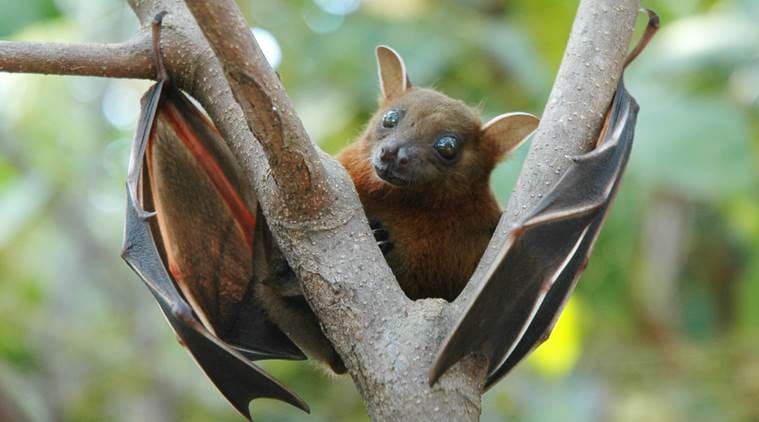 The Nipah virus is present in bat urine and potentially, bat faeces, saliva, and birthing fluids. (Source: Wikimedia Commons)
The Nipah virus is present in bat urine and potentially, bat faeces, saliva, and birthing fluids. (Source: Wikimedia Commons)
Nipah Virus is an emerging infectious disease that broke out in Malaysia and Singapore in 1998 and 1999. It first appeared in domestic pigs and has been found among several species of domestic animals including dogs, cats, goats, horses and sheep. The infection is also known to affect human beings. The organism which causes Nipah Virus encephalitis is an RNA or Ribonucleic acid virus of the family Paramyxoviridae, genus Henipavirus, and is closely related to Hendra virus.
Nipah virus infection gets its name from the village in Malaysia where the person from whom the virus was first isolated succumbed to the disease. The virus has been listed in the World Organisation for Animal Health (OIE) Terrestrial Animal Health Code and must be reported to the OIE (OIE Terrestrial Animal Health Code).

How does Nipah spread or get transmitted?
The disease spreads through fruit bats or ‘flying foxes,’ of the genus Pteropus, who are natural reservoir hosts of the Nipah and Hendra viruses. The virus is present in bat urine and potentially, bat faeces, saliva, and birthing fluids. Presumably, the first incidence of Nipah virus infection occurred when pigs in Malaysian farms came in contact with the bats who had lost their habitats due to deforestation. Furthermore, transmission between farms may be due to fomites – or carrying the virus on clothing, equipment, boots, vehicles.
Nipah Virus, which is a zoonotic disease, was known to affect humans in Malaysia and Singapore after coming in direct contact with the excretions or secretions of infected pigs. Reports from outbreaks in Bangladesh suggest transmission from bats in the process of drinking raw palm sap contaminated with bat excrement or climbing trees coated in the same.
Read | Nipah virus infection: First-ever case, symptoms, treatment
In Bangladesh and India, there have been reports of possible human-to-human transmission of the disease. Therefore, precautions are necessary for hospital workers in charge of taking care of the infected patients. Precautions should also be taken when submitting and handling laboratory samples, as well as in slaughterhouses.
Read | Everything you need to know about Nipah, in Malayalam
Symptoms of the Nipah infection
Typically, the human infection presents as an encephalitic syndrome marked by fever, headache, drowsiness, disorientation, mental confusion, coma, and potentially death. During the outbreak in Malaysia, up to 50 per cent of clinically apparent human cases died. There is no specific treatment for Nipah Virus. The primary treatment for human cases is intensive supportive care.
Most Read 1Chandrayaan-3 mission: Dawn breaks on Moon, all eyes on lander, rover to wake up 2As Indo-Canadian relations sour, anxiety grips Indian students, residents who wish to settle in Canada 3Karan Johar says Sanjay Leela Bhansali did not call him after Rocky Aur Rani: ‘He’s never called me but…’ 4Gadar 2 box office collection day 40: Hit by Shah Rukh Khan’s Jawan onslaught, Sunny Deol movie ends BO run with Rs 45 lakh earning 5Shubh’s tour in India cancelled: Why is the Canada-based singer facing the music?
Prevention of the Nipah infection
While there is no vaccine available for the infection, preventive measures can be a key to control the spread. With fruits bats being the primary cause of infection, the farm animals should be prevented from eating fruit contaminated by bats. Consumption of contaminated date palm sap including toddy should also be avoided. Physical barriers can be put in place in order to prevent bats from accessing and contaminating palm sap.
Medical officials who are looking after the patients with suspected or confirmed NiV should take basic precautions like washing hands, using a gown, cap mask and wearing gloves. For laboratory personnel, Nipah virus is classified internationally as a biosecurity level (BSL) 4 agent. BSL 2 facilities are sufficient if the virus can be first inactivated during specimen collection.
Also ReadWhat is the Aarushi Talwar murder case?What is Shah Bano case?What is the Chipko movement?What is Yeti?
In case of animals, wire screens can help prevent contact with bats when pigs are raised in open-sided pig sheds. Run-off from the roof should be prevented from entering pig pens. practice. Early recognition of infected pigs can help protect other animals and humans. Due to the highly contagious nature of the virus in swine populations, mass culling of seropositive animals may be necessary.
© IE Online Media Services Pvt Ltd

